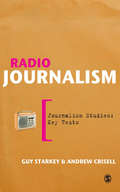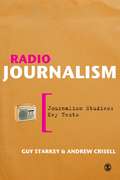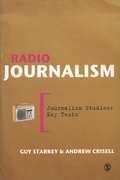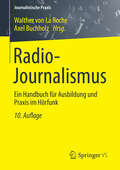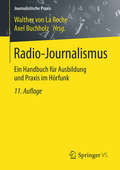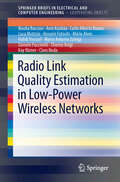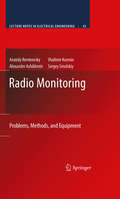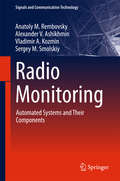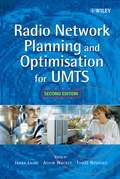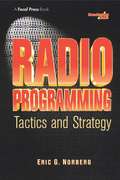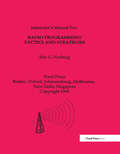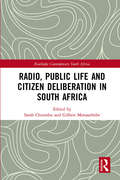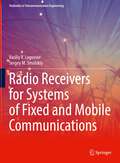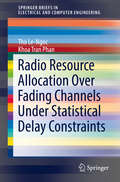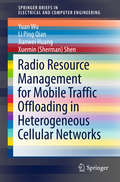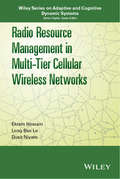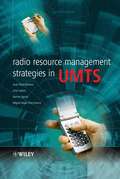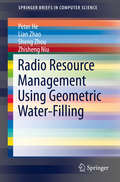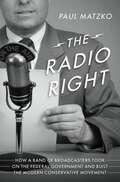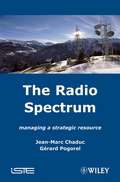- Table View
- List View
Radio Journalism
by Andrew Crisell Professor Guy Starkey"This is not another turgid guide to digital editing, writing for radio and the structure of a newsroom team. It is an ambitious and accessible study that combines a succinct narrative history of radio journalism with an analysis of its power in the public sphere. It describes the development of British audio broadcasting before locating it in an international context and contemplating the contours of the convergent future. Such ambition is often the prelude to failure. Instead, Starkey and Crisell have written a precious introduction to the theory, practice and purposes of radio journalism that will be very useful to serious students of the subject... This is a very good book." - THE (Times Higher Education) Radio Journalism introduduces key themes in journalism studies to explore what makes radio reporting distinctive and lay out the claims for radio's critical importance in the news landscape. With their extensive experience in radio production and academica, authors Guy Starkey and Andrew Crisell take readers on a tour through the past, present and future of radio broadcasting, from the infancy of the BBC in the 1920s up to the prospect of rolling news delivered to mobile telephones. Grounding each chapter in a survey of scholarly writing on the radio, they explore the connections between politics, policy and practice, inviting critical reflection on who radio professionals are, what they do and why. Putting theory and practice into dialogue, this book is the perfect bridge between unreflective production manuals and generalised media theory texts. Witty and engaging, Radio Journalism provides an essential framework for understanding the continuing relevance of radio journalism as a profession, set of practices and arena for critical debate.
Radio Journalism (PDF)
by Andrew Crisell Professor Guy Starkey"This is not another turgid guide to digital editing, writing for radio and the structure of a newsroom team. It is an ambitious and accessible study that combines a succinct narrative history of radio journalism with an analysis of its power in the public sphere. It describes the development of British audio broadcasting before locating it in an international context and contemplating the contours of the convergent future. Such ambition is often the prelude to failure. Instead, Starkey and Crisell have written a precious introduction to the theory, practice and purposes of radio journalism that will be very useful to serious students of the subject. . . This is a very good book. " - THE (Times Higher Education) Radio Journalism introduduces key themes in journalism studies to explore what makes radio reporting distinctive and lay out the claims for radio's critical importance in the news landscape. With their extensive experience in radio production and academica, authors Guy Starkey and Andrew Crisell take readers on a tour through the past, present and future of radio broadcasting, from the infancy of the BBC in the 1920s up to the prospect of rolling news delivered to mobile telephones. Grounding each chapter in a survey of scholarly writing on the radio, they explore the connections between politics, policy and practice, inviting critical reflection on who radio professionals are, what they do and why. Putting theory and practice into dialogue, this book is the perfect bridge between unreflective production manuals and generalised media theory texts. Witty and engaging, Radio Journalism provides an essential framework for understanding the continuing relevance of radio journalism as a profession, set of practices and arena for critical debate.
Radio Journalism (PDF)
by Guy StarkeyRadio Journalism introduduces key themes in journalism studies to explore what makes radio reporting distinctive and lay out the claims for radio's critical importance in the news landscape.
Radio-Journalismus: Ein Handbuch für Ausbildung und Praxis im Hörfunk (Journalistische Praxis)
by Walther La Roche Axel BuchholzWie kommen Sie zum Radio? Was müssen Sie lernen und können um beim modernen Radio Erfolg zu haben? "Radio-Journalismus" sagt Ihnen, was Sie brauchen und zeigt Ihnen, wie es geht. Das Standard Lehrbuch für die Radio-Ausbildung führt mit handfesten Anleitungen in die gesamte Radio-Praxis ein. Es beschreibt alle Ausbildungsmöglichkeiten und bringt praktische Tipps für Hospitanz, Praktikum und Volontariat beim Radio. Die Autoren sind selbst erfolgreche Radio-Macher. Viele unterrichten außerdem an Journalistenschulen, Universitäten und sonstigen Ausbildungseinrichtungen.
Radio-Journalismus: Ein Handbuch für Ausbildung und Praxis im Hörfunk (Journalistische Praxis)
by Walther von La Roche Axel BuchholzWie kommen Sie zum Radio? Was müssen Sie lernen und können um beim modernen Radio Erfolg zu haben? „Radio-Journalismus“ sagt Ihnen, was Sie brauchen und zeigt Ihnen, wie es geht.Wie werden z. B. Interviews geführt oder O-Ton-Berichte gemacht? Wie wird für das Radio geschrieben, wie moderiert? Wie werden Radio-Nachrichten gestaltet, Texte gesprochen oder die Musiktitel ausgewählt? Wie wird beim Radio crossmedial gearbeitet?Das Standard-Handbuch für die Radio-Ausbildung führt mit handfesten Anleitungen in die gesamte Radio-Praxis ein. Es beschreibt alle Ausbildungsmöglichkeiten und bringt praktische Tipps für Hospitanz, Praktikum und Volontariat beim Radio. Die Autoren sind zumeist selbst erfolgreiche Radio-Macher. Viele unterrichten außerdem an Journalistenschulen, Universitäten und sonstigen Ausbildungseinrichtungen.
Radio Link Quality Estimation in Low-Power Wireless Networks (SpringerBriefs in Electrical and Computer Engineering)
by Nouha Baccour Anis Koubâa Claro Noda Hossein Fotouhi Mário Alves Habib Youssef Marco Antonio Zúñiga Carlo Alberto Boano Kay Römer Daniele Puccinelli Thiemo Voigt Luca MottolaThis book provides a comprehensive survey on related work for radio link quality estimation, which covers the characteristics of low-power links, the fundamental concepts of link quality estimation in wireless sensor networks, a taxonomy of existing link quality estimators and their performance analysis. It then shows how link quality estimation can be used for designing protocols and mechanisms such as routing and hand-off. The final part is dedicated to radio interference estimation, generation and mitigation.
Radio Monitoring: Problems, Methods and Equipment (Lecture Notes in Electrical Engineering #43)
by Alexander Ashikhmin Vladimir Kozmin Sergey M. Smolskiy Anatoly RembovskyRadio Monitoring: Problems, Methods, and Equipment offers a unified approach to fundamental aspects of Automated Radio Monitoring (ARM). The authors discuss the development, modeling, design, and manufacture of ARM systems. Data from established and recent research are presented and recommendations are made on methods and approaches for solving common problems in ARM. The authors also provide classification and detailed descriptions of modern high-efficient hardware-software ARM equipment, including the equipment for detection, radio direction-finding, parameters measurement and their analysis, and the identification and localization of the electromagnetic field sources. Examples of ARM equipment structure, applications, and software are provided to manage a variety of complicated interference environment in the industrial centers, inside of the buildings, and in the open terrain. This book provides a reference for professionals and researchers interested in deploying ARM technology as a tool for solving problems from radio frequency spectrum usage control.
Radio Monitoring: Automated Systems and Their Components (Signals and Communication Technology #43)
by Anatoly M. Rembovsky Alexander V. Ashikhmin Vladimir A. Kozmin Sergey M. SmolskiyThis book discusses the architecture of modern automated systems for spectrum monitoring including automation components: technical means for spectrum monitoring, special software and engineering infrastructure. The problems of automated system development for search and localization of unauthorized radio emission sources in open localities, mathematical methods and algorithms for modulation of parameter measurements for wireless communication as well as issues of identification and localization of radio emission sources are considered. Constructive solutions and modern technical means for radio monitoring and their application are given. Numerous examples are described for the implementation of automated systems, digital radio receivers and radio direction-finders, analyzers of parameters for GSM, CDMA, LTE, DVB-T/T2, Wi-Fi, DMR, P25, TETRA and DECT signals. Practical implementations of the described methods are presented in applied software packages and in radio monitoring equipment.
Radio Network Planning and Optimisation for UMTS
by Jaana Laiho Achim Wacker Tomás NovosadRadio Network Planning and Optimisation for UMTS, Second Edition, is a comprehensive and fully updated introduction to WCDMA radio access technology used in UMTS, featuring new content on key developments. Written by leading experts at Nokia, the first edition quickly established itself as a best-selling and highly respected book on how to dimension, plan and optimise UMTS networks. This valuable text examines current and future radio network management issues and their impact on network performance as well as the relevant capacity and coverage enhancement methods. In addition to coverage of WCDMA radio access technology used in UMTS, and the planning and optimisation of such a system, the service control and management concept in WCDMA and GPRS networks are also introduced. This is an excellent source of information for those considering future cellular networks where Quality of Service (QoS) is of paramount importance. Key features of the Second Edition include: High-Speed Downlink Packet Access (HSDPA) – physical layer, dimensioning and radio resource management Quality of Service (QoS) mechanisms in network for service differentiation Multiple Input – Multiple Output (MIMO) technology Practical network optimisation examples Service optimisation for UMTS and GPRS/EDGE capacity optimisation The ‘hot topic’ of service control and management in WCDMA and GPRS networks, that has evolved since the first edition Companion website includes: Figures Static radio network simulator implemented in MATLAB® This text will have instant appeal to wireless operators and network and terminal manufacturers. It will also be essential reading for undergraduate and postgraduate students, frequency regulation bodies and all those interested in radio network planning and optimisation, particularly RF network systems engineering professionals.
Radio Programming: Tactics And Strategy (Broadcasting And Cable Ser.)
by Eric NorbergA practical handbook for programming directors, this guide focuses on achieving specific objectives in today's modern, competitive environment. Radio Programming is designed to convey underlying principles and to assist the programmer in accomplishing specific objectives, without mandating exact implementation methods. Instead, it empowers station management and the PD to implement strategies that will work for the particular format and market niche. Radio Programming will be helpful for neophytes in programming, experienced programmers seeking further growth, air talent seeking to develop skills, and general managers trying to understand programming and effectively manage program directors without stifling creativity. It will also help general managers hire effective programmers.Eric Norberg is the editor and publisher of the Adult Contemporary Music Research Letter and a radio consultant. He has worked as a program director at several radio stations, as on-air talent and general manager, and has also operated a radio production company. For fourteen years he has written a weekly column on radio programming for The Gavin Report, a radio trade publication.
Radio Programming Tactics and Strategies
by NorbertFirst published in 2002. Routledge is an imprint of Taylor & Francis, an informa company.
Radio Programming Tactics and Strategies
by NorbertFirst published in 2002. Routledge is an imprint of Taylor & Francis, an informa company.
Radio Programming: Tactics and Strategy
by Eric NorbergA practical handbook for programming directors, this guide focuses on achieving specific objectives in today's modern, competitive environment. Radio Programming is designed to convey underlying principles and to assist the programmer in accomplishing specific objectives, without mandating exact implementation methods. Instead, it empowers station management and the PD to implement strategies that will work for the particular format and market niche. Radio Programming will be helpful for neophytes in programming, experienced programmers seeking further growth, air talent seeking to develop skills, and general managers trying to understand programming and effectively manage program directors without stifling creativity. It will also help general managers hire effective programmers.Eric Norberg is the editor and publisher of the Adult Contemporary Music Research Letter and a radio consultant. He has worked as a program director at several radio stations, as on-air talent and general manager, and has also operated a radio production company. For fourteen years he has written a weekly column on radio programming for The Gavin Report, a radio trade publication.
Radio, Public Life and Citizen Deliberation in South Africa (Routledge Contemporary South Africa)
by Sarah ChiumbuThis book critically analyses the important role of radio in public life in post-apartheid South Africa. As the most widespread and popular form of communication in the country, radio occupies an essential space in the deliberation and the construction of public opinion in South Africa. From just a few state-controlled stations during the apartheid era, there are now more than 100 radio stations, reaching vast swathes of the population and providing an important space for citizens to air their views and take part in significant socio-economic and political issues of the country. The various contributors to this book demonstrate that whilst print and television media often serve elite interests and audiences, the low cost and flexibility of radio has helped it to create a ‘common’ space for national dialogue and deliberation. The book also investigates the ways in which digital technologies have enhanced the consumption of radio and produced a sense of imagined community for citizens, including those in marginalised communities and rural areas. This book will be of interest to researchers with an interest in media, politics and culture in South Africa specifically, as well as those with an interest in broadcast media more generally.
Radio, Public Life and Citizen Deliberation in South Africa (Routledge Contemporary South Africa)
by Sarah Chiumbu Gilbert MotsaathebeThis book critically analyses the important role of radio in public life in post-apartheid South Africa. As the most widespread and popular form of communication in the country, radio occupies an essential space in the deliberation and the construction of public opinion in South Africa. From just a few state-controlled stations during the apartheid era, there are now more than 100 radio stations, reaching vast swathes of the population and providing an important space for citizens to air their views and take part in significant socio-economic and political issues of the country. The various contributors to this book demonstrate that whilst print and television media often serve elite interests and audiences, the low cost and flexibility of radio has helped it to create a ‘common’ space for national dialogue and deliberation. The book also investigates the ways in which digital technologies have enhanced the consumption of radio and produced a sense of imagined community for citizens, including those in marginalised communities and rural areas. This book will be of interest to researchers with an interest in media, politics and culture in South Africa specifically, as well as those with an interest in broadcast media more generally.
Radio Receivers for Systems of Fixed and Mobile Communications (Textbooks in Telecommunication Engineering)
by Sergey M. Smolskiy Vasiliy V. LogvinovThe textbook acquaints the reader with the architecture of receivers of analog and digital radio systems, helps to study the stages of designing a modern radio receiver and reveals the reasons and methods for its effective operation in networks for various purposes. Particular attention is paid to the methods of generating and processing signals in the receivers of digital systems with multiple access, which make it possible to provide data transfer rates close to the maximum possible (according to Shannon). As a textbook for students studying methods of optimal signal reception, the book will also be useful to specialists in the field of telecommunications involved in the development of radio receivers. The book shows how the development of theoretical, circuitry and integrated technologies led to the active introduction of algorithmic methods for signal processing changed both the design of receivers and the methods of forming the information flow in free space (MIMO, beamforming). The creation of a global 5G network based on heterogeneous networks puts forward new requirements for the architecture of receivers, which are determined by the requirements to achieve high data rates, low time delays or use in networks with coordinated multipoint transmission and reception (CoMP). To consolidate the knowledge gained, the book includes a complete set of materials for online classes, including questions and answers, a guide to solving problems for each chapter, and computer modeling units of receivers in the MicroCAP environment, based on preliminary calculations.
Radio Resource Allocation Over Fading Channels Under Statistical Delay Constraints (SpringerBriefs in Electrical and Computer Engineering)
by Tho Le-Ngoc Khoa Tran PhanThis SpringerBrief presents radio resource allocation schemes for buffer-aided communications systems over fading channels under statistical delay constraints in terms of upper-bounded average delay or delay-outage probability. This Brief starts by considering a source-destination communications link with data arriving at the source transmission buffer. The first scenario, the joint optimal data admission control and power allocation problem for throughput maximization is considered, where the source is assumed to have a maximum power and an average delay constraints. The second scenario, optimal power allocation problems for energy harvesting (EH) communications systems under average delay or delay-outage constraints are explored, where the EH source harvests random amounts of energy from renewable energy sources, and stores the harvested energy in a battery during data transmission. Online resource allocation algorithms are developed when the statistical knowledge of the random channel fading, data arrivals, EH processes governing the system dynamics is unknown a-priori. This Brief continues with a source-relay-destination communications link with buffers available at both source and relay, as part of a multi-hop network. Optimal resource allocation schemes for this 3-node relaying system to maximize its effective capacity under a delay-outage constraint are proposed, with special emphasis on relay roles: Half-duplex (HD) or full-duplex (FD) relay operation. With HD relay, the adaptive link selection relaying problem jointly with both fixed and adaptive power allocation schemes is investigated. Within each transmission frame, either the source-relay link or the relay-destination link is selected to be active depending on the channel conditions. With FD relay under the presence of non-zero residual self-interference (SI). This Brief also presents source and relay power allocation schemes for both cases of available knowledge of the channel state information at transmitter (CSIT): instantaneous or statistical. Professional and researchers working in this related field and advanced-level students in electrical or computer engineering will find the content valuable as a reference.
Radio Resource Management for Mobile Traffic Offloading in Heterogeneous Cellular Networks (SpringerBriefs in Electrical and Computer Engineering)
by Yuan Wu Li Ping Qian Jianwei Huang Xuemin Sherman ShenThis SpringerBrief offers two concrete design examples for traffic offloading. The first is an optimal resource allocation for small-cell based traffic offloading that aims at minimizing mobile users’ data cost. The second is an optimal resource allocation for device-to-device assisted traffic offloading that also minimizes the total energy consumption and cellular link usage (while providing an overview of the challenging issues). Both examples illustrate the importance of proper resource allocation to the success of traffic offloading, show the consequent performance advantages of executing optimal resource allocation, and present the methodologies to achieve the corresponding optimal offloading solution for traffic offloading in heterogeneous cellular networks. The authors also include an overview of heterogeneous cellular networks and explain different traffic offloading paradigms ranging from uplink traffic offloading through small cells to downlink traffic offloading via mobile device-to-device cooperation.This brief is an excellent resource for postgraduate students studying advanced-level topics in wireless communications and networking. Researchers, engineers and professionals working in related fields will also find this brief a valuable resource tool.
Radio Resource Management in Multi-Tier Cellular Wireless Networks (Adaptive and Cognitive Dynamic Systems: Signal Processing, Learning, Communications and Control)
by Ekram Hossain Long Bao Le Dusit NiyatoProviding an extensive overview of the radio resource management problem in femtocell networks, this invaluable book considers both code division multiple access femtocells and orthogonal frequency-division multiple access femtocells. In addition to incorporating current research on this topic, the book also covers technical challenges in femtocell deployment, provides readers with a variety of approaches to resource allocation and a comparison of their effectiveness, explains how to model various networks using Stochastic geometry and shot noise theory, and much more.
Radio Resource Management in Multi-Tier Cellular Wireless Networks (Adaptive and Cognitive Dynamic Systems: Signal Processing, Learning, Communications and Control)
by Ekram Hossain Long Bao Le Dusit NiyatoProviding an extensive overview of the radio resource management problem in femtocell networks, this invaluable book considers both code division multiple access femtocells and orthogonal frequency-division multiple access femtocells. In addition to incorporating current research on this topic, the book also covers technical challenges in femtocell deployment, provides readers with a variety of approaches to resource allocation and a comparison of their effectiveness, explains how to model various networks using Stochastic geometry and shot noise theory, and much more.
Radio Resource Management Strategies in UMTS
by Jordi Perez Romero Oriol Sallent Ramon Agusti Miguel Angel Diaz-GuerraThe key feature of future mobile communication systems is the ability to deliver wideband and high bit-rate multimedia services alongside the traditional radio services such as voice, messaging and slow rate data. The broad range of services expected to be supported can be divided into different Quality of Service (QoS) classes. However, the provision of such mobile multimedia services under QoS guarantees will not be possible without a utilization of the air interface resources by means of Radio Resource Management (RRM) strategies that ensure the target QoS, the planned coverage area and that offer a high system capacity. Under this framework, the book focuses on the RRM concepts, including the theoretical background that serves as a basis for the description of specific RRM algorithms. The RRM problem for UMTS is presented, and more specifically, for the FDD mode, which is based on a WCDMA scheme. More specifically, the different aspects that are covered include: Introduces the mobile communications sector and UMTS, including the evolution towards 4G systems, with an overview of the QoS concept which is key for the definition of RRM strategies Offers a detailed description of the radio interface in UMTS, as the basis for the implementation of RRM strategies Provides the fundamental concepts related with the development of RRM strategies in WCDMA networks Analyses particular RRM algorithms in a variety of scenarios, trying to identify the key parameters and factors that influence their performance Explores the evolution of UMTS towards Beyond 3G systems and the concept of Common RRM in heterogeneous networks with the aid of some algorithm examples This comprehensive title is essential reading for engineers and managers in radio engineering departments of UMTS network operators and UMTS equipment manufacturers. It will also prove insightful to researchers in the field of 3G and Beyond 3G systems and academics in any of these areas.
Radio Resource Management Using Geometric Water-Filling (SpringerBriefs in Computer Science)
by Peter He Lian Zhao Sheng Zhou Zhisheng NiuThis brief introduces the fundamental theory and development of managing radio resources using a water-filling algorithm that can optimize system performance in wireless communication. Geometric Water-Filling (GWF) is a crucial underlying tool in emerging communication systems such as multiple input multiple output systems, cognitive radio systems, and green communication systems. Early chapters introduce emerging wireless technologies and provide a detailed analysis of water-filling. The brief investigates single user and multi-user issues of radio resource management, allocation of resources, and energy harvesting. Effective algorithms demonstrate the incredible potential capabilities of water-filling mechanisms. This brief is designed for researchers and professionals working with resource management and wireless communications. Advanced-level students in computer science and engineering will also find the information valuable.
The Radio Right: How a Band of Broadcasters Took on the Federal Government and Built the Modern Conservative Movement
by Paul MatzkoIn the past few years, trust in traditional media has reached new lows. Many Americans disbelieve what they hear from the "mainstream media," and have turned to getting information from media echo chambers which are reflective of a single party or ideology. In this book, Paul Matzko reveals that this is not the first such moment in modern American history. The Radio Right tells the story of the 1960s far Right, who were frustrated by what they perceived to be liberal bias in the national media, particularly the media's sycophantic relationship with the John F. Kennedy administration. These people turned for news and commentary to a resurgent form of ultra-conservative mass media: radio. As networks shifted their resources to television, radio increasingly became the preserve of cash-strapped, independent station owners who were willing to air the hundreds of new right-wing programs that sprang up in the late 1950s and 1960s. By the early 1960s, millions of Americans listened each week to conservative broadcasters, the most prominent of which were clergy or lay broadcasters from across the religious spectrum, including Carl McIntire, Billy James Hargis, and Clarence Manion. Though divided by theology, these speakers were united by their distrust of political and theological liberalism and their antipathy towards JFK. The political influence of the new Radio Right quickly became apparent as the broadcasters attacked the Kennedy administration's policies and encouraged grassroots conservative activism on a massive scale. Matzko relates how, by 1963, Kennedy was so alarmed by the rise of the Radio Right that he ordered the Internal Revenue Service and Federal Communications Commission to target conservative broadcasters with tax audits and enhanced regulatory scrutiny via the Fairness Doctrine. Right-wing broadcasters lost hundreds of stations and millions of listeners. Not until the deregulation of the airwaves under the Carter and Reagan administrations would right-wing radio regain its former prominence. The Radio Right provides the essential pre-history for the last four decades of conservative activism, as well as the historical context for current issues of political bias and censorship in the media.
The Radio Right: How a Band of Broadcasters Took on the Federal Government and Built the Modern Conservative Movement
by Paul MatzkoIn the past few years, trust in traditional media has reached new lows. Many Americans disbelieve what they hear from the "mainstream media," and have turned to getting information from media echo chambers which are reflective of a single party or ideology. In this book, Paul Matzko reveals that this is not the first such moment in modern American history. The Radio Right tells the story of the 1960s far Right, who were frustrated by what they perceived to be liberal bias in the national media, particularly the media's sycophantic relationship with the John F. Kennedy administration. These people turned for news and commentary to a resurgent form of ultra-conservative mass media: radio. As networks shifted their resources to television, radio increasingly became the preserve of cash-strapped, independent station owners who were willing to air the hundreds of new right-wing programs that sprang up in the late 1950s and 1960s. By the early 1960s, millions of Americans listened each week to conservative broadcasters, the most prominent of which were clergy or lay broadcasters from across the religious spectrum, including Carl McIntire, Billy James Hargis, and Clarence Manion. Though divided by theology, these speakers were united by their distrust of political and theological liberalism and their antipathy towards JFK. The political influence of the new Radio Right quickly became apparent as the broadcasters attacked the Kennedy administration's policies and encouraged grassroots conservative activism on a massive scale. Matzko relates how, by 1963, Kennedy was so alarmed by the rise of the Radio Right that he ordered the Internal Revenue Service and Federal Communications Commission to target conservative broadcasters with tax audits and enhanced regulatory scrutiny via the Fairness Doctrine. Right-wing broadcasters lost hundreds of stations and millions of listeners. Not until the deregulation of the airwaves under the Carter and Reagan administrations would right-wing radio regain its former prominence. The Radio Right provides the essential pre-history for the last four decades of conservative activism, as well as the historical context for current issues of political bias and censorship in the media.
The Radio Spectrum: Managing a Strategic Resource
by Jean-Marc Chaduc G¿rard PogorelRadio frequencies have become a basic resource for the development of the information society. In fact, radio waves are a mandatory vehicle in order to carry the message to customers and a truly worldwide communication needs their properties. Given the market demands for more and more frequencies, means have to be found to share this limited resource most effectively and to continuously improve its efficiency. Radio spectrum management is thus a major objective for our modern world. This book describes the current tools for spectrum management with their fundamental technical and legal basis. It outlines the global evolution of radio services in their different application domains and introduces the actors who contribute to the collective management of the spectrum. It also discusses the main questions these actors have to deal with and answer in order to design for the future.
